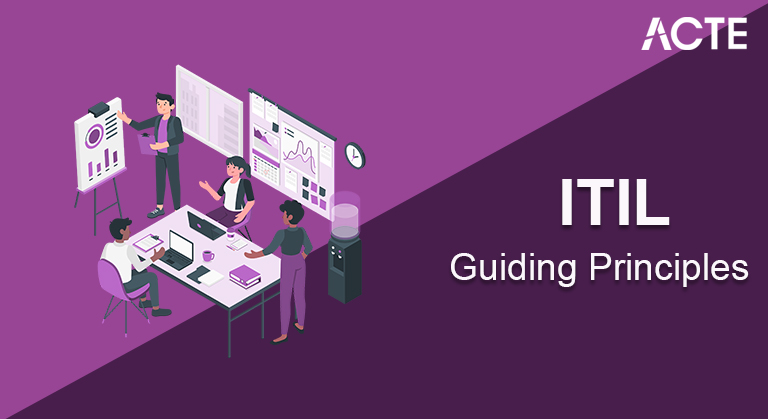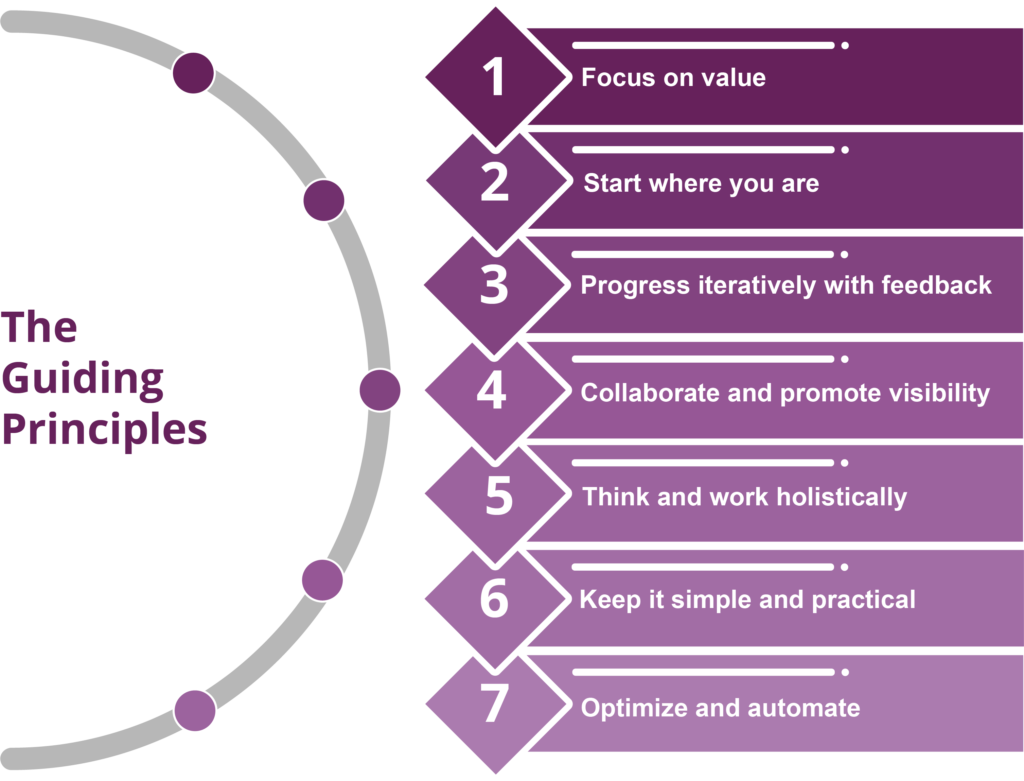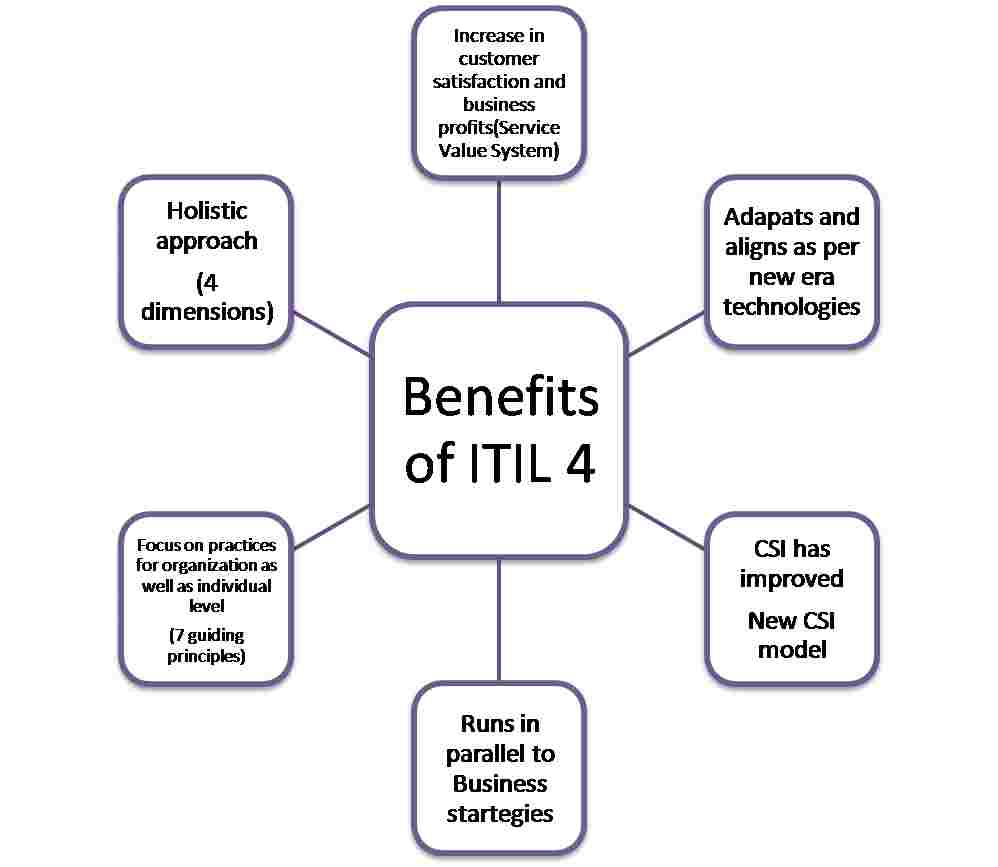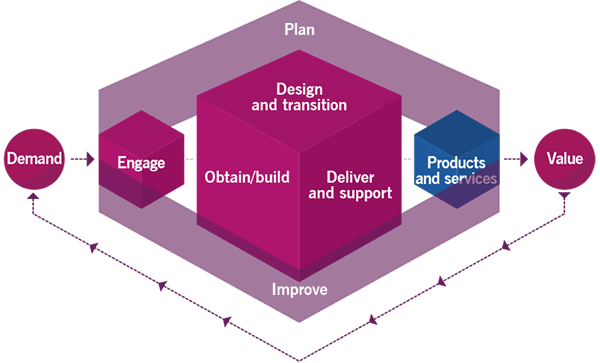
Guiding Principles of ITIL 4 | Learn Now Tutorial
Last updated on 03rd Feb 2022, Blog, Tutorials
- Introduction to ITIL4 Guiding Principles
- ITIL®4 Guiding Principles Features
- ITIL 4: Key ideas
- The 7 ITIL guiding principle don’t remain solitary
- Instructions to utilize the guiding principle
- ITIL administration value framework and worth chain
- Benefits of ITIL 4 Guiding Principles
- Conclusion
- The guiding principle support constant improvement.
- Each core value applies to a determination of the accessible partner gatherings.
- Associations ought to conclude which one of the guiding principle is pertinent to them.
- Associations ought to consider how the guiding principle connect.
- The guiding principle characterized in ITIL®4 book epitomize the central messages of ITIL and administration the board as a general rule, supporting effective activities and great choices of various kinds and at all levels. The guiding principle are the upsides of suggestions that offer direction on the right conduct for doing specific things. Standards are widespread, self-approving, and enabling which must be followed, all through the lifecycle of the administration.
- There should be a heading set followed (adjusted) by the clients and experts, which is a fundamental quality of a framework. Standards mirror the motivation behind the framework’s plan, its destinations and guarantee the viability of activity and worth acknowledgment, which would be incomprehensible if standards are not thought of.
- The guiding principle are utilized to direct associations in the work taken on by an association for a way to deal with IT Service Management. These guiding principle are adjusted for the particular conditions and needs of an association. These help and empower associations on persistent premise to guarantee their accomplishment Services.
- View at what exists as equitably as could be expected, involving the client or the ideal result as the beginning stage.
- Whenever instances of effective practices or administrations are found in the present status, decide whether and how these can be imitated or developed to accomplish the ideal state.
- Apply your gamble the board abilities.
- Perceive that occasionally nothing from the present status can be re-utilized.
- Perceive the intricacy of the frameworks
- Joint effort is vital to thinking and working holistically
- Where conceivable, search for designs in the requirements of and collaborations between framework components
- Mechanization can work with working holistically
- Comprehend and concur the setting where the proposed enhancement exists
- Evaluate the present status of the proposed enhancement
- Concur what the future state and needs of the association ought to be, zeroing in on improvement and worth
- Guarantee the improvement has the fitting degree of partner commitment and responsibility
- Execute the upgrades in an iterative manner
- Consistently screen the effect of streamlining
- Rearrange or potentially improve before mechanizing
- Use computerization to decrease work: assignments which are manual, strategic, without suffering worth or potentially straightly scaling
- Characterize your measurements
- Utilize the other guiding principle while applying this one.
- As an association you don’t pick a couple of standards to apply, you ought to consider the pertinence of every one of them and how they apply together. The 7 guiding principles communicate and rely on one another. None are basic, yet all could be helpful.
- The guiding principle ought to be looked into on each event to evaluate how proper they are. The 7 ITIL guiding principle are all-around appropriate to essentially any drive and to all associations with partners.
- It is essential to allude to the standards at each dynamic cycle or plan of progress. Yet additionally, when you are stuck, face a few difficulties, or need some assistance. You could even consider printing them out and hanging them in someplace where you can see them on numerous occasions a day!
Introduction to ITIL4 Guiding Principles:
Have you perused the initial segment of this article? You might get a kick out of the chance to check out the outline of the significance of creating guiding principle before bouncing into these four stages to foster standards.
What is a principle?
A rule is a thought or idea which imparts how choices ought to be made and activities taken. A guideline is generally acknowledged because it has been attempted and tried across various varieties of a similar expansive circumstance. On a very basic level, standards convey shrewdness: a perspective with regards to a circumstance that has been demonstrated as significant.
In business, standards are significant because they permit pioneers to extensively impact how individuals think and work without getting straightforwardly engaged with each issue or challenge. They empower pioneers to revert navigation down the association, engage workers to simply decide and make moves without acceleration. At the point when individuals disguise these thoughts, they become a piece of the ethos and character of the association. They become a piece of the association’s way of life; some portion of its “muscle memory”. Through the foundation of standard, an association’s way of life changes, and individuals act with a particular goal in mind without a steady course.
What is the Purpose of guiding principle?
Guiding principle are virtues that set a norm for conduct and mentality inside a working environment. Organization’s layout guiding principle to shape the way of life of their workplace and guarantee that their representatives get what moral conduct they anticipate.
Which two explanations about the guiding principle are right?
How would you develop guiding principle for a project?
Four Steps to Creating Guiding Principles:
1. Articulate the Values. To make your guiding principle, you should have effectively recognized your best 3-5 fundamental beliefs.
2. Identify the Irrational Rules, Policies, Procedures.
3. Develop the Guiding Principles.
4. Apply the Principles.

ITIL®4 Guiding Principles Features:
For instance: If one of the standards of an association says “High trustworthiness”, each representative of the association needs to exhibit a significant degree of respectability in all that they do, at all levels. This guideline can’t be different for various people, various jobs, various positions (authority), and so forth, and won’t change now and again.
There are seven standards characterized in ITIL®4, which are recorded beneath;
1. Focus on value
2. Start where you are
3. Progress iteratively with feedback
4. Collaborate and advance perceivability
5. Think and work holistically
6. Keep it basic and practical
7. Optimize and automate
These seven standards supplement the standards referenced in other accepted procedures and principles like COBIT, Agile, DevOps, lean, and so forth, which empower the IT administration the executive’s practices of an association to adjust and coordinate to praise to these prescribed procedures and guidelines.
1. Focus on Value:
All that the association truly does should interface back, straightforwardly or in a roundabout way, to an incentive for itself, its clients, and different partners. While zeroing in on value, the initial step is to realize who are the clients and key partners being served. Then, it is essential to have a comprehension of what constitutes value according to the customer’s point of view. At long last, it is basic to comprehend the client’s involvement in the assistance and the association all in all through a reasonable consciousness of the client experience (CX) or client experience (UX). CX can be characterized as the sum of the connections a client has with an association and its items and consequently is both level-headed and abstract. To apply this standard effectively, think about this counsel:
a) Realize how administration buyers utilize each assistance.
b) Energize attention on value among all staff.
c) Zero in on value during ordinary functional movement as well as during progress drives.
d) Remember a concentration for value in each progression of any improvement drive.
2. Start where you are:
While undertaking an improvement opportunity, it isn’t required or shrewd to eliminate what has been done previously and fabricate something new, as this can be inefficient as far as time and additional cost as well as lost an open door to use of what exists. Try not to begin once again without first thinking about what is now accessible to be utilized.
Administrations and strategies currently set up ought to be estimated and additionally noticed straightforwardly to appropriately comprehend their present status and what can be re-utilized from them. Choices on the most proficient method to continue should be founded on data that is pretty much as exact as could be expected. Notwithstanding, estimation ought to be utilized to help the examination of what has been noticed rather than to supplant it, as over-dependence on information investigation and detailing can accidentally present predispositions and dangers in direction. To apply this rule effectively, think about this counsel:
3. Progress iteratively with feedback:
Oppose the impulse to do everything simultaneously. By getting sorted out work into more modest, sensible segments (cycles) that can be executed and finished sooner rather than later, the attention on every work will be more honed and simpler to keep up with. In any case, the general drive, as well as its part cycles, should be ceaselessly reconsidered and possibly overhauled to mirror any progressions in conditions and guarantee that the emphasis on value has not been lost. Looking for and utilizing feedback previously, during, and after every cycle will guarantee that activities are engaged and suitable, even in evolving conditions. Once got, feedback can be examined to distinguish improvement open doors, dangers, and issues. To apply this guideline effectively, think about this counsel:
1. Understand the entire, however, accomplish something.
2. The environment is continually changing, so input is fundamental.
3. Quick doesn’t mean deficient.
4. Collaborate and advance perceivability:
At the point when drives affect the perfect individuals in the right jobs, endeavors benefit from better purchase in, more importance (since better data is accessible for navigation), and improved probability of long-haul achievement. Incorporation is for the most part a preferred approach over rejection (storehouse action) since savvy fixes, exciting commitments, and significant viewpoints can be acquired from unforeseen sources. Cooperating such that prompts genuine achievement requires data, comprehension, and trust. The main significant advance is distinguishing and dealing with all the partner bunches that an association manages. The first and most clear partner bunch is the clients, as in assistance the board the association’s principal objective is to work with client results. Different instances of partner cooperation include:
1. Designers working with other inward groups
2. Providers working together with the association
3. Relationship supervisors working together with administration shoppers
4. Clients teaming up with one another
5. Inside and outside providers working together with one another
The commitment to the progress of every partner bunch at each level ought to be perceived, as should the best techniques to draw in with them. Contingent upon the help and the connection between the specialist organization and the assistance shopper, the assumptions regarding the level and sort of joint effort can differ fundamentally. It is essential to include partners, and address their requirements at all levels. Deciding the sort, technique, and recurrence of such informing are one of the focal exercises connected with correspondence.
Whenever partners have helpless perceivability of the responsibility and movement of work, there is a gamble of making the feeling that the work isn’t really important. Inadequate perceivability of work prompts helpless navigation, which thusly impacts the association’s capacity to work on inner abilities. To stay away from this, the association needs to perform such basic investigation exercises as understanding the progression of work underway, distinguishing bottlenecks and overabundance limit, and revealing waste. To apply this standard effectively, think about this counsel:
a) Joint effort doesn’t mean agreement
b) Communication
5. Think and work holistically:
No assistance, practice, cycle, office, or provider remains solitary. The results that the association conveys to itself, its clients, and different partners will experience except if it works in an incorporated manner to deal with its exercises in general, rather than as independent parts. Adopting an all-encompassing strategy to support the executives incorporates laying out comprehension of how every one of the pieces of an association cooperates in a coordinated manner (recall the four components of administration the board?), including having a start to finish perceivability of how request is caught and converted into results. In a perplexing framework, the modification of one component can affect others and, where conceivable, these effects should be recognized, investigated, and made arrangements for. To apply this guideline effectively, think about this exhortation:

6. Keep it straightforward and down to earth:
Continuously utilize the base number of steps to achieve a target. Result-based reasoning ought to be utilized to create commonsense arrangements that convey important results. Assuming a cycle, administration, activity or metric neglects to offer some incentive or produce a valuable result, then, at that point, dispose of it. Attempting to answer each special case will regularly prompt over-confusion. All things considered; decisions should be planned that can be utilized to deal with exemptions by and large.
Basic to keeping administration the executives basic and useful is seeing precisely the way that something adds to value creation. For instance, work including administrative consistency may not appear to be critical to support groups managing client issues. It is important to layout and impart a comprehensive perspective on the association’s work so individual groups or gatherings can see how their work is being impacted by, and thusly impacts, others. While planning, making due, or working practices, be aware of clashing targets. For instance, supervisors might need a ton of information, yet administration groups may be compelled in focusing on the assortment of that information. The association must settle on harmony between its contending targets. To apply this rule effectively, think about this counsel:
1. Guarantee value
2. Straightforwardness is a definitive refinement
3. Do fewer things, yet improve
4. Regard the hour of individuals included
5. Clearer, bound to embrace
6. Effortlessness is the best course to accomplishing speedy successes
7. Improve and computerize:
Associations should boost the worth of the work completed by their human and specialized assets. Innovation can assist associations with increasing and taking on regular and tedious assignments, permitting HR to be utilized for more intricate independent direction. Another age of mental instruments is further widening these open doors. Be that as it may, innovation ought not forever to be depended upon without the ability of human intercession, as robotization for the wellbeing of computerization can expand costs and lessen authoritative power and flexibility. Streamlining means to make something as successful and helpful as it should be. Before a movement can be automated, it ought to be enhanced to anything that degree is conceivable and sensible. Fundamentally, cutoff points are set on the advancement of administrations and practices, as they exist inside a bunch of limitations for example monetary, consistency, time or assets. There are numerous manners by which practices and administrations can be upgraded. No matter what the particular procedures, the way to streamlining follows these significant level advances:
Mechanization regularly alludes to the utilization of innovation to play out a stage or series of steps accurately and reliably with restricted or no human mediation. In its most straightforward structure, be that as it may, computerization could likewise mean the normalization and smoothing out of manual errands, for example, characterizing the principles of part of a cycle to permit choices to be made ‘naturally’. Effectiveness can be enormously expanded by diminishing the requirement for human inclusion to pause and assess each piece of a cycle. This incorporates saving the association costs, lessening human blunders, and further developing representative experience. To apply this guideline effectively, think about this counsel:
ITIL 4: Key ideas:
1. In the initial segment of ITIL 4, I see a ton of natural terms, like specialist co-ops, partners, gambles, and so on Be that as it may, the attention on value is new.
2. The meaning of administration the board is A bunch of particular authoritative abilities for empowering worth to clients as administrations. Also in that definition, value is portrayed as a bidirectional relationship where worth is co-made.
3. That is likewise where administration connections come in. Value is the way the shopper of the help encounters it nothing more, not all that much. There’s a major center shift to client experience (CX) rather than on conveying administrations from past ITIL renditions. That is significant since it lines up with the No. 1 concentration in assistance the executives.
4. Another center shift goes from processes toward acknowledging results. Furthermore, thinking about the worth concentration, it is really directed to comprehend that this result needs to bring value. A significant job to get to this result is spread out in help connections. In this way, once more, a major spotlight on cooperation.
The most effective method to utilize the 7-guiding principle:
The 7 ITIL guiding principle don’t remain solitary:
These standards are associated with ITIL as well as are reflected in numerous different structures, strategies, norms, methods of reasoning, or potentially assemblages of information. This permits associations to coordinate the utilization of numerous strategies in a general way to deal with the administration of the board.
Instructions to utilize the guiding principle:
Every one of these guiding principle offers incredible counsel, yet you get the most worth when you consolidate them. It would be senseless to zero in on value today and afterward streamline and automate tomorrow. All things considered, allude to every one of the guiding principles and contemplate how they can assist you, each time you with having to settle on a choice, or plan an improvement. For instance, if you will plan another interaction for occurrence the executives:
Start where you are: Review the current episode of the board cycle and recognize things that function admirably and ought to be kept or even based on.
Work together and advance perceivability: Include clients, clients, and providers in the group that is planning the improvement. This will assist with ensuring the cycle functions admirably for everybody, and that individuals are focused on supporting the new interaction.
Zero in on value: Make sure that each progression in your new interaction makes value, yet don’t simply contemplate an incentive for clients and clients, ponder the wide range of various partners as well. Ponder the client excursion and plan an extraordinary encounter for them.
Keep it straightforward and functional: Don’t make a massively intricate work process that will work for each conceivable circumstance, make a basic cycle that works for most circumstances and depending on your kin to accomplish something else when required.
Progress iteratively with feedback: Try out your new cycle in a protected climate. See what works and what doesn’t, and afterward make upgrades. Perhaps you’ll recognize a few circumstances where you truly need to determine a more point-by-point process, however, this will be founded on real perceptions, not only speculations concerning what will occur.
Improve and robotize: Start with a manual interaction first. Work out how to improve the work process. At the point when you have this right, robotize it. Try not to begin by planning the work process into your instruments; assuming you do that you might wind up squandering assets upgrading how you’ve effectively treated, you might be left with apparatuses that don’t work how you want them to.
Think and work holistically: Remember that occurrence the board isn’t just about reestablishing IT ability. Ensure that your interaction thinks about the effect on your clients’ business, and recognize ways that you can work on the general effect, in addition to the part that IT is answerable for. A portion of my clients printed the ITIL Practitioner guiding principle on enormous pieces of paper and stuck them on the dividers of their gathering rooms. This went about as an incredible brief when they were simply deciding or arranging upgrades.

ITIL 4 administration value framework and worth chain:
The assistance value framework discusses how all parts and exercises of an association cooperate to work with value creation. The focal piece of the framework is the assistance value chain, which clarifies the genuine exercises: plan, improve, connect with, plan and progress, get and construct, and convey and uphold. These exercises don’t stream in one straight manner. Particularly while keeping to the “progress iteratively” approach out of the guiding principle, a progression of exercises can be rehashed.
Benefits of ITIL 4:
The progress iteratively with feedback principle will help you ensure you are always focused on value; especially in a rapidly changing environment. The interplay between these principles means that they cannot be “implemented” or adopted one by one.
Conclusion:
The guiding principle are perhaps the most helpful and pragmatic pieces of ITIL 4, they aren’t only hypotheses for individuals to learn and rehash back in a test. On the off chance that you share these standards with every one of your kin, and use them while you’re deciding, then, at that point, you will improve occupation of making an incentive for your clients, your clients, and your association.

